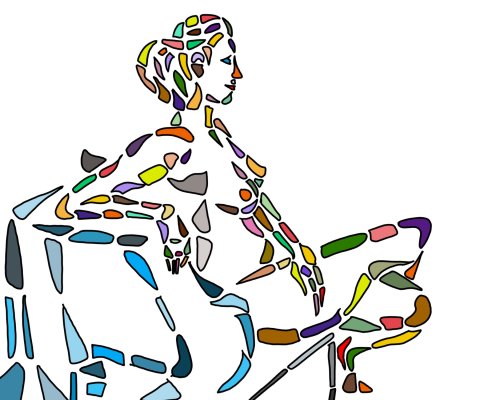The Shard series began as an experiment during life drawing sessions — quick studies of the human figure, completed within fifteen to thirty minutes. Instead of drawing continuous lines, I broke the form into coloured fragments: irregular shapes, each isolated, disconnected, and yet belonging to a coherent whole.
At first glance, these marks seem scattered, almost abstract. But the moment we look at them, something remarkable happens: the eye reorganizes the fragments, and a figure emerges almost instantly. The mind bridges the gaps, binding the pieces into a unified perception of a human body.
This phenomenon can be understood through the lens of Gestalt psychology — not to be confused with Gestalt therapy, but the branch of early twentieth-century psychology that explored how our perceptual system organizes visual information. Gestalt theory proposed that perception operates according to certain innate principles: we group nearby elements (proximity), connect those that share colour or form (similarity), and follow the smooth flow of lines and curves (continuity). We mentally close incomplete contours (closure), and instinctively separate figure from background (figure-ground). For instance, a dotted circle appears whole, and a line interrupted by another shape still feels continuous. Our eyes fill the missing parts, and the mind insists on coherence. These processes allow us to see a coherent structure even when the image itself is fragmented or ambiguous.
These principles are not abstract theories to me — they describe our tools for seeing. In the Shard drawings, I wanted to test our perceptual resilience — to see how much distortion or fragmentation the human visual system can tolerate before recognition fails. At what point does a figure stop being a figure? How far can we stretch perception before it breaks? These questions belong as much to cognitive psychology as to art.
Artistically, I find beauty in the tension between clarity and disintegration. The white spaces between the coloured forms are as important as the forms themselves; they act like pauses in a sentence, giving rhythm and breath. The colours shift across the body like facets of stained glass — a fractured anatomy that remains whole in the mind’s eye.
Each drawing is made from direct observation, but abstraction enters through economy: simplifying, omitting, allowing chance to intrude. Within the short span of a life-drawing pose, intuition and memory work together — mapping not anatomy, but perception itself. The Shard series stands somewhere between drawing and cognitive experiment: it explores how we reconstruct coherence from fragments, how recognition arises from disorder.
The Shard series stands somewhere between drawing and cognitive experiment. It reflects my ongoing interest in how the human mind interprets incomplete information — how we reconstruct coherence from fragments, how recognition arises from disorder. Science provides the conceptual framework; art provides the method of exploration. In the end, these works are not about breaking the figure apart, but about revealing the mind’s quiet, miraculous habit of putting the world back together.

